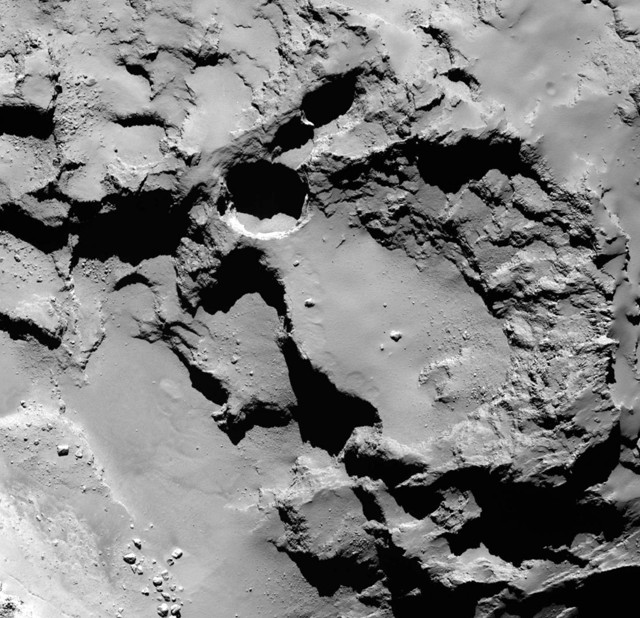
by Timothy Oleson Thursday, October 8, 2015

This and other pits on comet 67P may be sinkholes rather than craters. Credit: Vincent et al., Nature, 2015.
Large circular pits seen on comet 67P/Churyumov-Gerasimenko by the European Space Agency’s Rosetta spacecraft may be sinkholes rather than craters left by explosive eruptions or impacts, according to scientists who analyzed images taken by Rosetta’s OSIRIS camera.
A team led by Jean-Baptiste Vincent of the Max Planck Institute for Solar System Research in Göttingen, Germany, studied 18 holes in the comet’s Northern Hemisphere. The holes, up to a few hundred meters deep, tend to be clustered together, and some appear to be actively growing, they reported in Nature. Previously, as Rosetta approached 67P in spring 2014, it observed an explosive outburst from the comet’s surface, but the amount of material ejected at that time could not alone account for the size of any of the pits.
Vincent and colleagues hypothesize that the steep-sided pits result from sublimation of underground ices — water, carbon dioxide and carbon monoxide mainly — that comprise much of the comet’s material. When enough ice vaporizes in a particular spot and the remaining rock can no longer support its own weight, it collapses — a process akin to the main mechanism of sinkhole formation on Earth, in which acidic waters dissolve subterranean rock until the overlying surface comes crashing down.
The researchers noted that sinkhole formation on the comet could be accompanied by outbursts of debris into space, and that the pits probably continue to grow around the edges due to ongoing sublimation, with loosened debris gradually filling in the pits. Thus, pit sizes, shapes and depths could indicate relative ages of different parts of the comet’s surface: “A fresh cometary surface will have a ragged structure with many pits, while an evolved surface will look smoother,” they wrote.
© 2008-2021. All rights reserved. Any copying, redistribution or retransmission of any of the contents of this service without the expressed written permission of the American Geosciences Institute is expressly prohibited. Click here for all copyright requests.